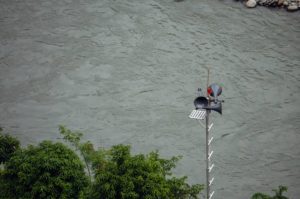Gariahat Electrocution Death: Kolkata continues to reel under the aftermath of record rainfall that left large parts of the city submerged, traffic paralyzed, and citizens battling floodwaters. The grim toll of the disaster deepened when yet another body was recovered in Gariahat, taking the count of suspected electrocution deaths to nine within city limits.

The latest victim, identified as Badal Garu, was discovered late Tuesday night after water levels receded along Nandi Street in the bustling Gariahat area. Preliminary investigations suggest he may have come into contact with a loose electrical wire while trying to navigate flooded streets. His body has been sent for post-mortem examination.
This tragedy has amplified concerns over urban infrastructure safety, particularly the interaction between drainage failures, waterlogging, and exposed electrical systems during extreme weather.
Gariahat Electrocution Death: How the Tragedy Unfolded
- Residents of Nandi Street first noticed the body as floodwaters began to drain away.
- Witnesses said the victim, believed to be in his mid-40s, had last been seen near the Gariahat market during the heavy downpour.
- Locals suspect he was electrocuted after unknowingly touching a live wire submerged in water.
- Authorities quickly moved the body for forensic examination while deploying CESC and civic workers to check for more exposed lines.
Police confirmed that with this incident, the city’s flood-related death toll has climbed sharply. Many of the victims over the past 48 hours have died under similar circumstances — electrocution while wading through waterlogged streets.
The Broader Context of Kolkata’s Flooding
The death in Gariahat is not an isolated episode but part of a larger unfolding disaster:
- Record-breaking rainfall battered Kolkata, overwhelming its century-old drainage system.
- High tide in the Hooghly River forced closure of sluice gates, preventing stormwater outflow.
- Waterlogging persisted in key hubs including Park Circus, Ballygunge, Dhakuria, Behala, and New Alipore.
- Normal life was thrown out of gear with major roads, shops, and even hospitals cut off.
Kolkata Municipal Corporation (KMC) admitted that much of the drainage network, laid in the colonial era, remains inadequate for present-day volumes of rain. Proposals for modern pumping stations, desilting, and underground reservoirs have faced delays.
Electrocution as a Hidden Killer
Experts emphasize that while drowning is often assumed to be the primary danger during urban floods, electrocution is an equally lethal threat.
- Floodwaters hide broken power lines, open junction boxes, and illegally tapped cables.
- Residents stepping into ankle- or knee-deep water may unknowingly brush against live wires.
- Continuous rainfall makes insulation brittle, leading to current leakage.
The Kolkata Police Disaster Management Group has urged citizens to avoid wading through water unless absolutely necessary. The KMC and CESC have also appealed to residents to immediately report sagging wires or sparking poles.
Administrative Measures & Accountability
Following the spate of deaths, civic authorities and power utilities are under pressure to act:
- Compensation Announced: The state government has declared financial relief for families of electrocution victims.
- Power Disconnections: CESC has been ordered to cut electricity in flood-prone pockets until safety inspections are complete.
- Joint Task Force: A coordination unit between KMC engineers, power supply officials, and disaster response teams is being set up to minimize risks.
- Drainage Reviews: Plans to speed up desilting and expansion of the drainage network are being revisited.
While these steps may bring temporary respite, urban planners warn that without structural modernization, Kolkata will continue to face life-threatening challenges during heavy monsoons.
Citizens’ Anger and Daily Struggles
Public frustration is mounting as families grapple with loss, disruption, and lack of safety assurances.
- Gariahat shopkeepers lamented that flooding during Puja season has hit businesses hard.
- Parents expressed fear about sending children to school in flood-affected neighborhoods.
- Many residents accused civic authorities of poor preparedness despite weather alerts.
Social media has been flooded with images of submerged cars, toppled trees, and electrocution warnings shared by local communities.
Way Forward: Preventing Future Disasters
Experts recommend a multi-layered strategy to prevent repeats of such tragedies:
- Urban Infrastructure Revamp
- Upgrade stormwater drainage with modern pumps and reservoirs.
- Elevate electric junction boxes above flood levels.
- Electrical Safety Protocols
- Mandatory waterproofing of streetlights and public junctions.
- Routine safety inspections before and during monsoon.
- Emergency Action Plans
- Pre-emptive power shutdowns in high-risk areas during heavy rain.
- Deployment of rescue teams equipped with insulated gear.
- Public Awareness Campaigns
- Alerts via SMS and social media urging people not to wade through water.
- Community volunteers trained to identify and cordon off dangerous zones.
Government References & External Links
For citizens seeking official updates and safety advisories, the following resources are useful:
- Kolkata Municipal Corporation – Disaster Management Updates
- CESC Limited – Power Safety Notices
- West Bengal State Disaster Management Authority
- India Meteorological Department – Weather Bulletins
- Ministry of Power, Government of India
Conclusion
The discovery of a ninth body in Gariahat is not just a statistic but a human tragedy that exposes Kolkata’s vulnerability in the face of extreme weather. The interplay of poor drainage, fragile electrical networks, and administrative lapses continues to endanger lives.
Unless the city prioritizes climate-resilient infrastructure and flood-safe electrical systems, the cycle of rains, floods, and deaths may tragically repeat in the years to come.
Also read: Home | Channel 6 Network – Latest News, Breaking Updates: Politics, Business, Tech & More

